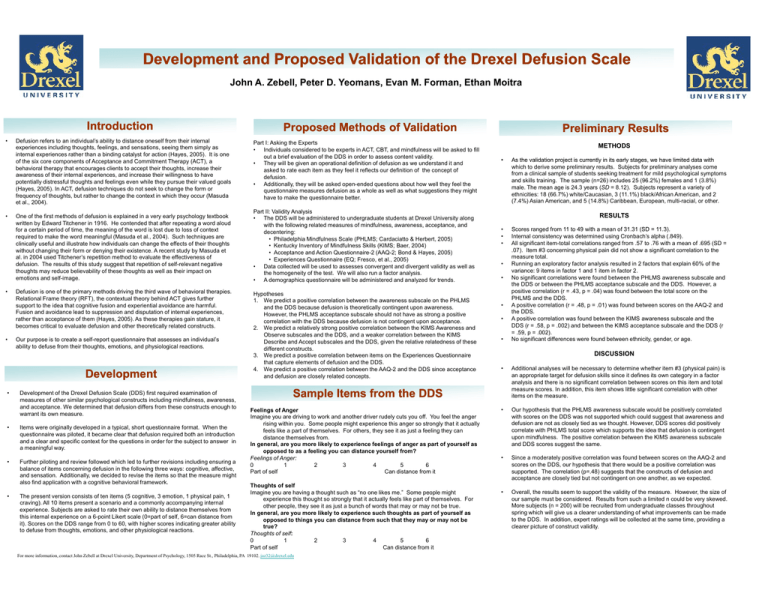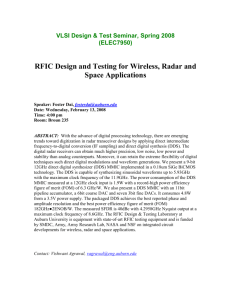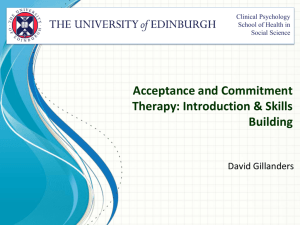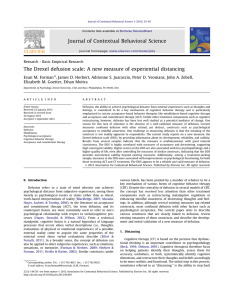Development and Proposed Validation of the Drexel Defusion Scale
advertisement

Development and Proposed Validation of the Drexel Defusion Scale John A. Zebell, Peter D. Yeomans, Evan M. Forman, Ethan Moitra Introduction • • • • Part I: Asking the Experts • Individuals considered to be experts in ACT, CBT, and mindfulness will be asked to fill y out a brief evaluation of the DDS in order to assess content validity. • They will be given an operational definition of defusion as we understand it and asked to rate each item as they feel it reflects our definition of the concept of defusion. • Additionally, they will be asked open-ended questions about how well they feel the questionnaire measures defusion as a whole as well as what suggestions they might have to make the questionnaire better. One of the first methods of defusion is explained in a very early psychology textbook written by Edward Titchener in 1916. He contended that after repeating a word aloud for a certain period of time, the meaning of the word is lost due to loss of context required to make the word meaningful (Masuda et al., 2004). Such techniques are clinically useful and illustrate how individuals can change the effects of their thoughts without changing their form or denying their existence. A recent study by Masuda et al. in 2004 used Titchener’s repetition method to evaluate the effectiveness of defusion. The results of this study suggest that repetition of self-relevant negative thoughts may reduce believability of these thoughts as well as their impact on emotions and self-image. Part II: Validity Analysis • The DDS will be administered to undergraduate students at Drexel University along g related measures of mindfulness,, awareness,, acceptance, p , and with the following decentering: • Philadelphia Mindfulness Scale (PHLMS; Cardaciatto & Herbert, 2005) • Kentucky Inventory of Mindfulness Skills (KIMS; Baer, 2004) • Acceptance and Action Questionnaire-2 (AAQ-2; Bond & Hayes, 2005) • Experiences Questionnaire (EQ; Fresco, et al., 2005) • Data collected will be used to assesses convergent and divergent validity as well as the homogeneity of the test. We will also run a factor analysis. • A demographics questionnaire will be administered and analyzed for trends. Defusion is one of the primary methods driving the third wave of behavioral therapies. Relational Frame theory (RFT), the contextual theory behind ACT gives further support to the idea that cognitive fusion and experiential avoidance are harmful. Fusion and avoidance lead to suppression and disputation of internal experiences, rather than acceptance of them (Hayes, 2005). As these therapies gain stature, it becomes critical to evaluate defusion and other theoretically related constructs. Our purpose is to create a self-report questionnaire that assesses an individual’s ability to defuse from their thoughts, emotions, and physiological reactions. Development • Proposed Methods of Validation Defusion refers to an individual’s ability to distance oneself from their internal experiences including thoughts, feelings, and sensations, seeing them simply as internal experiences rather than a binding catalyst for action (Hayes, 2005). It is one off the h six i core components off Acceptance A and dC Commitment i Th Therapy (ACT) (ACT), a behavioral therapy that encourages clients to accept their thoughts, increase their awareness of their internal experiences, and increase their willingness to have potentially distressful thoughts and feelings even while they pursue their valued goals (Hayes, 2005). In ACT, defusion techniques do not seek to change the form or frequency of thoughts, but rather to change the context in which they occur (Masuda et al., 2004). Development of the Drexel Defusion Scale (DDS) first required examination of measures of other similar psychological constructs including mindfulness, awareness, and acceptance. We determined that defusion differs from these constructs enough to warrant its own measure. • Items were originally developed in a typical, short questionnaire format. When the questionnaire ti i was piloted, il t d it became b clear l that th t d defusion f i required i db both th an iintroduction t d ti and a clear and specific context for the questions in order for the subject to answer in a meaningful way. • Further piloting and review followed which led to further revisions including ensuring a balance of items concerning defusion in the following three ways: cognitive, affective, and sensation. Additionally, we decided to revise the items so that the measure might also find application with a cognitive behavioral framework. • The present version consists of ten items (5 cognitive, 3 emotion, 1 physical pain, 1 craving). i ) All 10 it items presentt a scenario i and d a commonly l accompanying i iinternal t l experience. Subjects are asked to rate their own ability to distance themselves from this internal experience on a 6-point Likert scale (0=part of self, 6=can distance from it). Scores on the DDS range from 0 to 60, with higher scores indicating greater ability to defuse from thoughts, emotions, and other physiological reactions. yp Hypotheses 1. We predict a positive correlation between the awareness subscale on the PHLMS and the DDS because defusion is theoretically contingent upon awareness. However, the PHLMS acceptance subscale should not have as strong a positive correlation with the DDS because defusion is not contingent upon acceptance. 2. We predict a relatively strong positive correlation between the KIMS Awareness and Observe subscales and the DDS, and a weaker correlation between the KIMS Describe and Accept subscales and the DDS, given the relative relatedness of these different constructs. 3. We predict a positive correlation between items on the Experiences Questionnaire p elements of defusion and the DDS. that capture 4. We predict a positive correlation between the AAQ-2 and the DDS since acceptance and defusion are closely related concepts. Preliminary Results METHODS • As the validation project is currently in its early stages stages, we have limited data with which to derive some preliminary results. Subjects for preliminary analyses come from a clinical sample of students seeking treatment for mild psychological symptoms and skills training. The sample (n=26) includes 25 (96.2%) females and 1 (3.8%) male. The mean age is 24.3 years (SD = 8.12). Subjects represent a variety of ethnicities: 18 (66.7%) white/Caucasian, 3 (11.1%) black/African American, and 2 (7.4%) Asian American, and 5 (14.8%) Caribbean, European, multi-racial, or other. • • • Scores ranged S d ffrom 11 tto 49 with ith a mean off 31.31 31 31 (SD = 11 11.3). 3) Internal consistency was determined using Cronbach’s alpha (.849). All significant item-total correlations ranged from .57 to .76 with a mean of .695 (SD = .07). Item #3 concerning physical pain did not show a significant correlation to the measure total. Running an exploratory factor analysis resulted in 2 factors that explain 60% of the variance: 9 items in factor 1 and 1 item in factor 2. No significant correlations were found between the PHLMS awareness subscale and the DDS or between the PHLMS acceptance subscale and the DDS. However, a positive correlation (r = .43, p = .04) was found between the total score on the PHLMS and d th the DDS. DDS A positive correlation (r = .48, p = .01) was found between scores on the AAQ-2 and the DDS. A positive correlation was found between the KIMS awareness subscale and the DDS (r = .58, p = .002) and between the KIMS acceptance subscale and the DDS (r = .59, p = .002). No significant differences were found between ethnicity, gender, or age. RESULTS • • • • • DISCUSSION • Additional analyses will be necessary to determine whether item #3 (physical pain) is an appropriate target for defusion skills since it defines its own category in a factor analysis and there is no significant correlation between scores on this item and total measure scores. In addition, this item shows little significant correlation with other items on the measure. • Our hypothesis that the PHLMS awareness subscale would be positively correlated with scores on the DDS was not supported which could suggest that awareness and defusion are not as closely tied as we thought. However, DDS scores did positively pp the idea that defusion is contingent g correlate with PHLMS total score which supports upon mindfulness. The positive correlation between the KIMS awareness subscale and DDS scores suggest the same. • Since a moderately positive correlation was found between scores on the AAQ-2 and scores on the DDS, our hypothesis that there would be a positive correlation was supported. The correlation (p=.48) suggests that the constructs of defusion and acceptance are closely tied but not contingent on one another, as we expected. • Overall, the results seem to support the validity of the measure. However, the size of p must be considered. Results from such a limited n could be very y skewed. our sample More subjects (n = 200) will be recruited from undergraduate classes throughout spring which will give us a clearer understanding of what improvements can be made to the DDS. In addition, expert ratings will be collected at the same time, providing a clearer picture of construct validity. Sample Items from the DDS Feelings of Anger Imagine you are driving to work and another driver rudely cuts you off. You feel the anger rising within you. Some people might experience this anger so strongly that it actually part of themselves. For others,, theyy see it as just j a feeling g they y can feels like a p distance themselves from. In general, are you more likely to experience feelings of anger as part of yourself as opposed to as a feeling you can distance yourself from? Feelings of Anger: 0 1 2 3 4 5 6 Part of self Can distance from it Thoughts of self Imagine you are having a thought such as “no one likes me.” Some people might p this thought g so strongly g y that it actually y feels like p part of themselves. For experience other people, they see it as just a bunch of words that may or may not be true. In general, are you more likely to experience such thoughts as part of yourself as opposed to things you can distance from such that they may or may not be true? Thoughts of self: 0 1 2 3 4 5 6 Part of self Can distance from it For more information, contact John Zebell at Drexel University, Department of Psychology, 1505 Race St., Philadelphia, PA 19102. jaz32@drexel.edu






